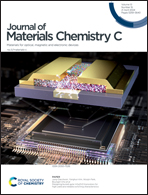A passivation strategy assisting a robust and low consumption power BP-based optical synaptic device for neural computing†
Abstract
Two-dimensional black phosphorous (BP) memristors have great promise for developing high-performance visual synapses in AI robots, emulating the human eye, stemming from the tunable bandgap width and excellent optoelectronic performance of BP. However, 2D BP's instability hampers its widespread adoption. To address this bottleneck, BP–GOQD (graphene oxide quantum dot) visual synaptic devices have been successfully fabricated by a graphene oxide quantum dot passivation strategy, graphene shielding and a synergistic coupling effect. The experimental results demonstrate that the formation of P–C bonds through graphene oxide encapsulation can greatly improve the stability of the devices. Even when exposed to the atmosphere for up to 30 months, the unencapsulated devices still exhibited excellent performance and remarkably low power consumption (1.7 nJ per single pulse). These devices can well simulate the behaviors of dendritic neuron and Pavlovian conditioned reflex. Moreover, thanks to the excellent computational abilities of BP–GOQD visual synapses, the spike neural network built upon this structure can achieve image recognition within a remarkably small number of cycles. Furthermore, the detection results attain an impressive accuracy rate of 90.1%, demonstrating a high level of precision in the field of visual recognition. This study's focus on improving BP-based device stability paves the way for efficient photosynapse devices in artificial intelligence.



 Please wait while we load your content...
Please wait while we load your content...